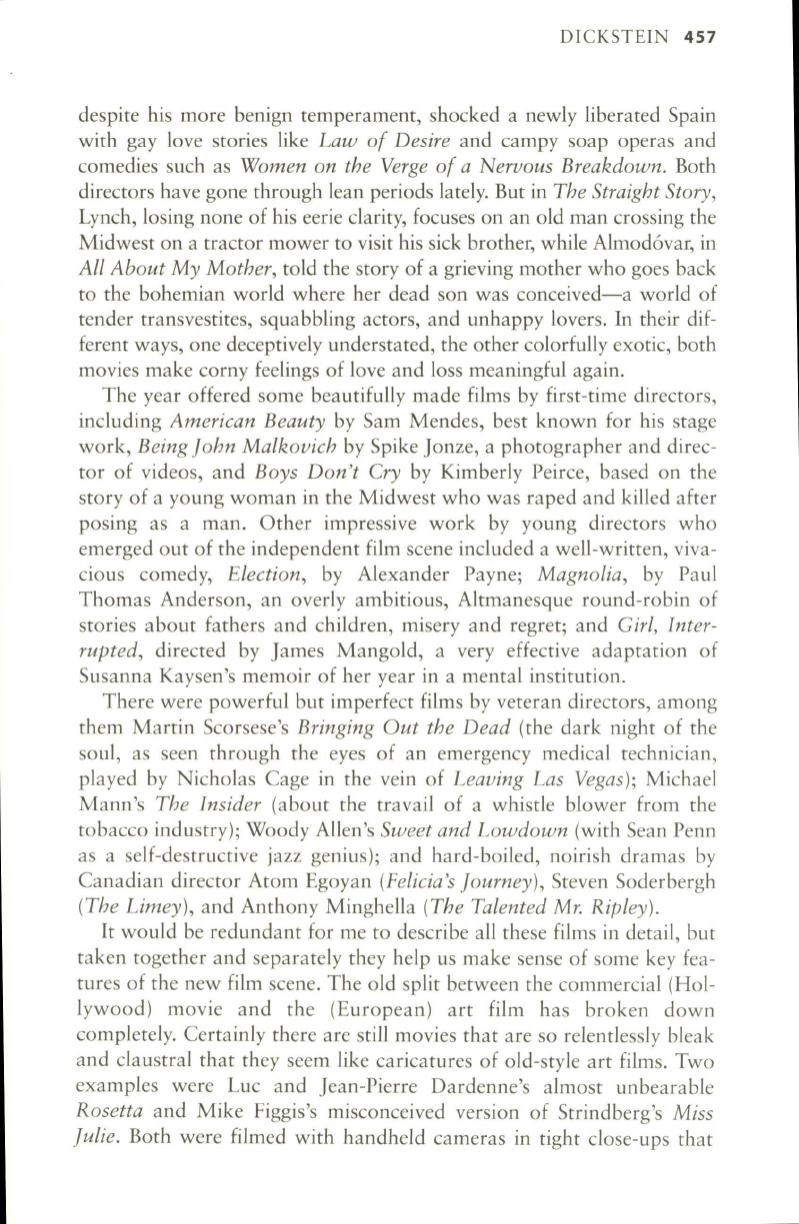
DICKSTEIN
457
despite his more benign temperament, shocked a newly liberated Spain
with gay love stories like
Law of Desire
and campy soap operas and
comedies such as
Women on the Verge of a Nervous Breakdown.
Both
directors have gone through lean periods lately. But in
The Straight Story,
Lynch, losing none of his eerie clarity, focuses on an old man crossing the
Midwest on a tractor mower to visit his sick brother, while Almodovar, in
All About My Mother,
told the story of a grieving mother who goes back
to the bohemian world where her dead son was conceived-a world of
tender transvestites, squabbling actors, and unhappy lovers.
In
their dif–
ferent ways, one deceptively understated, the other colorfully exotic, both
movies make corny feelings of love and loss meaningful again.
The year offered some beautifully made films by first-time directors,
including
American Beauty
by Sam Mendes, best known for his stage
work,
Being John Malkovich
by Spike Jonze, a photographer and direc–
tor of videos, and
Boys Don't Cry
by Kimberly Peirce, based on the
story of a young woman in the Midwest who was raped and killed after
posing as a man. Other impressive work by young directors who
emerged out of the independent film scene included a well-written, viva–
cious comedy,
Election,
by Alexander Payne;
Magnolia,
by Paul
Thomas Anderson, an overly ambitious, Altmanesque round-robin of
stories about fathers and children, misery and regret; and
Girl, Inter–
rupted,
directed by James Mangold, a very effective adaptation of
Susanna Kaysen's memoir of her year in a mental institution.
There were powerful but imperfect films by veteran directors, among
them Martin Scorsese's
Bringing Out the Dead
(the dark night of the
soul, as seen through the eyes of an emergency medical technician,
played by Nicholas Cage in the vein of
Leaving Las Vegas);
Michael
Mann's
The Insider
(about the travail of a whistle blower from the
tobacco industry); Woody Allen's
Sweet and Lowdown
(with Sean Penn
as a self-destructive jazz genius); and hard-boiled, noirish dramas by
Canadian director Atom Egoyan
(Felicia's Journey),
Steven Soderbergh
(The Limey),
and Anthony Minghella
(The Talented Mr. Ripley).
It
would be redundant for me to describe all these films in detail, but
taken together and separately they help us make sense of some key fea–
tures of the new film scene. The old split between the commercial (Hol–
lywood) movie and the (European) art film has broken down
completely. Certainly there are still movies that are so relentlessly bleak
and c1austral that they seem like caricatures of old-style art films. Two
examples were Luc and Jean-Pierre Dardenne's almost unbearable
Rosetta
and Mike Figgis's misconceived version of Strindberg's
Miss
Julie.
Both were filmed with handheld cameras in tight close-ups that


